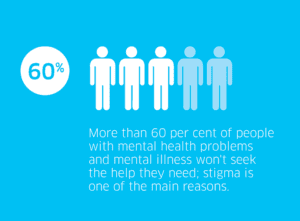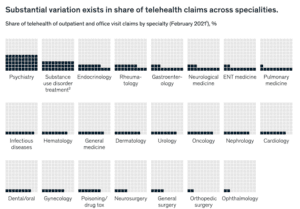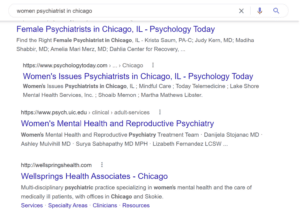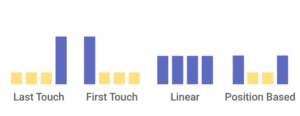In today’s world, a successful mental health patient acquisition strategy has to be in tune with patients’ needs and how they prefer to find care. While people have become more aware of the need for mental health services, the stigma around the subject remains. Therefore, potential patients primarily turn to the Internet when researching mental health services.
This means mental health service providers must
- Capture top-of-the-funnel patients when they’re seeking information online
- Capture bottom-of-the-funnel patients ready to book an appointment
- Create a seamless experience for easy conversion
- Manage their reputation to build strong relationships and support all digital campaigns
By leveraging an assay of digital marketing tools, best practices, and strategies, mental health care providers will build a robust and sustainable patient acquisition machine.
The Importance of Behavioral Health Digital Marketing
As mentioned earlier, stigma remains around the mental health topic that patients often find it uncomfortable to seek help or referral from their primary care doctors. In addition, patients hide their mental health struggles from friends, families, and employers.

As a result, most patients will conduct independent research through the channels they’re most comfortable. Therefore, digital marketing becomes key to the success of any mental health care center.
Build a User-Friendly Website
A well-optimized behavioral health service website is the foundation of your digital marketing strategy. Your website is your digital front door. Since patients prefer to gather mental health service information discreetly, your website must answer their questions and provide a means to move forward.
For example, a typical therapist’s website would provide the type of mental illnesses they specialize in and share information on their credentials and experience. It will also give the option to schedule an evaluation session or even provide a user login for returning patients to book appointments.
Other best practices for mental health service websites include
- Optimize for a faster website speed
- Build a friendly user interface (UI)
- Optimize for the mobile user. For example, add a click-to-call number to every page.
- Create dedicated pages for each field of focus and treatment program
- Make conversion easy with as little steps as possible
Communicating with Potential Patients
Remember that you work with a vulnerable audience when creating your website’s messaging. Therefore, it’s crucial to brand your mental health service center in a way that’s educational, informative, and compassionate. Your goal should be to create a safe space where potential patients feel comfortable reaching out for help.
Meanwhile, your website should always provide honest, detailed information on treatment programs, accepted insurance, practicing therapists and psychiatrists, etc.
Making Conversion Easy
Remember that your patients are skeptical and on high alert when searching for mental health resources. Therefore, the faster and better you can answer their questions, the more likely they’ll move forward.
That’s why leveraging new technologies like automated chatbots and Facebook Messenger integration are a great addition to your website strategy. According to a recent Salesforce study, 69% of consumers prefer to use chatbots because they provide instant responses. Meanwhile, 55% of consumers are willing to interact with a business via messaging apps to solve a problem.
Additionally, unlike addiction treatment centers, mental healthcare providers are allowed to use online scheduling, which gives the patient more control over the process.
Telehealth Marketing
As of July 21, telehealth usage was 38 times higher compared to the pre-pandemic era, and providers and consumers have developed a more welcoming attitude towards telehealth services.
Amid the COVID-19 pandemic, therapists, psychiatrists, and other mental health care providers began incorporating telehealth into their standard treatment structure to ensure people could receive care. And in the months since, it’s become a unique selling proposition as it allows people to receive the care they need at their convenience.

At the start of the pandemic, LifeStance rolled out a nationwide telehealth offering that quickly became a traffic driver with the appropriate SEO strategy. This propelled them to the top of Google and helped ignite their growth to more than 500 locations across the nation.
Since then, telehealth platforms and apps like Better Help, TalkSpace, and Ginger.io have made the patient acquisition competition more complex than before. With these newer platforms leveraging new strategies like paid social ads, video marketing, and influencer marketing, traditional mental health service providers must stay aware of the latest marketing trends to maintain and increase their market share.
Telehealth Marketing Best Practices
If you offer telehealth services, make it known. Leverage call-only ads to capture patients from the mobile end and initiate a direct conversation at their solution-seeking moment. Also, telehealth marketing may help you reach a new market segment thanks to its convenience and accessibility.
Also, telehealth is still relatively new, and not everyone feels comfortable explaining their mental health struggles over a video call in their dining room or during a lunch break. Therefore, craft your messaging with empathy and focus on educating your patients, share telehealth success stories to boost your credibility, and create telehealth-specific campaigns for maximum results.
Learn more about telehealth marketing best practices
Local SEO
Local SEO should be the bread and butter of your digital patient acquisition strategy for any multi-location mental health service provider. Essentially, mental health is a local service since long traveling would make the already-uncomfortable patient feel even more out of place.
Therefore, most individuals first turn toward Google Maps or use location-based search terms when seeking mental health care services online. For example, “therapists near me” had a 368,000 monthly search volume. Meanwhile, “mental health near me” had a 14,800 monthly search volume. Even with the growth of telehealth, the majority of people still prefer seeing a therapist in person somewhere close.
Mental Health Service Local SEO Best Practices
Start building your local SEO with these best practices.
Citations & Listings
List your organization on local directories and niche lists. For example, almost every state and county has a behavioral health directory. When creating listings, target authoritative directories and provide the most accurate information. Your business name, address, and phone must be consistent across all listings and your website.
Google Business Profile (GBP) Optimization
Create a Google My Business Profile (formerly Google My Business) listing for each location and update each with the correct information, including addresses, hours of operation, and COVID-19 protocols. We also recommend creating an FAQ for each location to briefly explain your treatment programs and insurance requirements.
Geographical Keyword Strategy
Again, mental health care is a local service. Therefore, targeting solution-aware geographical keywords can help you capture BOFU prospects ready to convert. Some great keywords to explore include:
- Depression treatment near me
- Women psychiatrist in Chicago
- Therapists accept medicare in Kansas City

Well-optimized Location Pages
Optimize your organization’s location page to target patients in each market. Be sure to list the treatment programs and therapists specific to each branch instead of using duplicate content. You need to include copy that is relevant to that location and the patients that would visit it.
Read our article to get more tips for optimizing your location pages.
Brand Reputation Management
Your online reviews can significantly impact your local SEO. For example, GBP listings with online reviews are trusted by 73% of consumers. Meanwhile, patients also use reviews to determine if a therapist or organization is a good fit. Meanwhile, good reviews also give therapists and psychiatrists the confidence to send referrals to you.
Getting More Positive Reviews
First of all, make leaving reviews easy. Create conspicuous CTA buttons for leaving reviews like an interactive star selector or a review submission form.
Next, reach out to your existing patients. Sometimes people simply forget to leave a review, and a simple reminder could mean a big difference for your practice.
You can also invest in review-gathering software, such as a text-to-review tool, to take yourself out of the process. We recommend our clients partner with Podium or Birdeye to simplify review generation.
Learn more about how to get more positive reviews
Online Reputation Management for Mental Health Services
However, reputation management is more than collecting positive reviews. Unfortunately, one negative review could easily sabotage your reputation management effort for the past month. Therefore, the key to online reputation management is staying aware of your listings and their ratings.
When you notice negative comments, respond respectfully but be mindful that you can’t share personal information, and you comply with HIPAA. It’s best to acknowledge the review and try to take the conversation offline. Be cautious with deleting or hiding negative reviews, however. An organization with only positive reviews sometimes becomes suspicious of review censoring and could raise a red flag.
Learn more about digital healthcare provider reputation management
Enhance Your Lead Quality
In mental health marketing, it’s not just about filling your pipeline with leads—it’s about attracting the right ones. Too often, I see mental health practices drowning in a sea of mismatched inquiries. Their marketing efforts cast a wide net, pulling in high volumes of leads, but many of these potential patients aren’t the right fit for their services. The result is a frustrating cycle of unconverted leads, wasted time, and drained resources.
This is where improvement of lead quality comes into play. Here are the steps:
Define Your Ideal Client
Understand who benefits most from your services. Are you specialized in treating specific disorders? Do you work best with certain age groups or demographics? Clearly defining your ideal client allows you to tailor your marketing efforts more effectively.
Conduct thorough research to understand what your ideal patients are searching for online. Use tools like keyword research, customer surveys, and call tracking analysis to identify common problems and questions potential clients have.
Refine Your Unique Selling Proposition (USP)
What sets your mental health practice apart? It could be your specialized training, unique treatment approaches, or the atmosphere of your practice. Communicate this USP clearly in your marketing materials to attract suitable patients.
Improve Ad Creative
Create ads that speak directly to your ideal clients’ needs and concerns. Instead of generic messaging, try something more laser-focused like “Specialized PTSD Treatment for Veterans” or “Compassionate Therapy for New Mothers Struggling with Postpartum Depression.”
Ensure your ad is creative and the copy embodies your USP in engaging ways. Use compelling visuals and clear, empathetic language that resonates with your target audience.
Implement Lead Tracking
Use HIPAA-compliant technologies to track which marketing efforts are bringing in quality leads. This might include call tracking software or CRM systems designed for healthcare providers such as Salesforce and Zoho.
Next, analyze metrics like the length of the buyer’s journey, click-through rates, conversion rates, and customer acquisition costs to understand which strategies are most effective.
Nurture Leads
Mental health decisions often require considerable thought. Implement a lead nurturing strategy that provides value and builds trust over time. This could include sending helpful resources, offering free webinars on mental health topics, or providing a series of educational emails.
Remember to monitor your sales process closely. Ensure that inquiries are being responded to promptly and that leads aren’t getting lost in your CRM system. Regular follow-ups and a well-structured nurturing process can significantly improve your conversion rates.
Google Ads
Google Ads allows mental health care service providers to capture audiences at the decision-making cusp. For example, if someone uses a solution-aware keyword, such as “depression therapists taking new patients now,” they’re seeking immediate solutions. Then, Google ads can place you directly in front of that person on top of the SERP, even if you didn’t optimize for the specific query in their search.
Google Ads Account Structure For Mental Health Services
Your account structure is the foundation of your entire Google Ads strategy and determines how efficient and effective your campaigns can be. Media managers can build their ad accounts based on a spectrum of most segmented to most consolidated.
A segmented account provides maximum control and is therefore favored by many multi-location organizations since they often assign a specific monthly budget for each location. However, segmentation isn’t the most effective method to improve ad performance anymore, and hyper-segmentation could backfire and reduce performance and return on ad spend.
On the other hand, we have consolidated accounts with the goal of maximizing impression per ad group. Usually, the only segmentation in a consolidated structure would be brand and non-brand. Consolidated accounts work hand-in-hand with Google’s smart bidding system and require minimum manual action.
Finally, we have the hybrid account structure, which is the most frequently used model. As the name suggests, hybrid accounts combine segmentation and consolidation function on two tiers, with one focusing on AI bidding for higher impressions and the other controlled manually for better performance with more specific targeting.
Learn more about Google Ads account structure
PPC Best Practices for Mental Health Services
Once you’ve developed a light-weight yet robust account structure, you’re ready to take advantage of Google’s AI-powered bidding strategies. The right account structure provides Google’s smart bidding tool with the necessary data to optimize your bidding. Then, focus on testing different smart bidding strategies, so you spend more efficiently.
Next, diversify your keyword strategy to cover the entire funnel. Similarly, choose the appropriate landing page for leads in each funnel stage, and optimize accordingly to provide a user-friendly, relevant, and seamless experience. However, always maximize your BOF keywords to capture as many ready-to-buy patients as possible.
Learn more about healthcare PPC strategies
LegitScript Certification for Telemedicine Providers
LegitScript is designed to protect consumers from fraudulent and malicious healthcare advertisers. LegitScript is currently partnering with Google, Microsoft, Facebook, TikTok, and major payment service providers to certify reliable, trustworthy healthcare websites.
While LegistScript isn’t mandatory for behavioral health services, it is still recommended, especially if you offer telehealth. LegitScript is a great way to build trust with consumers. It also makes online media buying more secure if you’re advertising beyond Google Ads.
Learn more about LegitScript for telehealth providers.
Marketing Analytics & Real-time ROI Measurement for Mental Health Providers
Data-driven marketing is the only true solution to scaling patient acquisition for today’s multi-location mental health service providers. Without clarity, organizations will never understand how their campaigns perform in the real world. As a result, no optimization can occur, and ROI is untrackable.
Closed-Loop Reporting
Healthcare marketers can achieve the best performance by implementing closed-loop reporting (CLR). CLR system ties revenue and patient data back to marketing activities. Your team can then identify what marketing pieces contributed to which stage of patient acquisition.
However, the healthcare industry faces some unique challenges regarding CLR implementation. For example,
- Manual tracking might be necessary to capture the acquisition accurately
- Direct traffic attribution can be over-generalized
- Cookieless browsers and new privacy restrictions make data less accessible
- HIPAA regulations mandate the data you’re able to use
Organizations can overcome these limitations by developing a comprehensive analytics strategy.
Learn more about closed-loop reporting for mental health care providers
Data-driven Marketing for Mental Health Services
Measuring healthcare marketing performance can be challenging. Therefore, start with developing a single source of truth that houses all marketing systems, activities, and data to eliminate unnecessary silos and redundant workflows.
Next, improvise communications between your marketing, revenue, and operation teams. Address goals for each department with separate KPIs to identify pieces that can be improved. You can also leverage industry benchmarks to assess your organization’s performance on a larger scale.
It is also essential for a mental health service provider to use the right attribution model on each report. The four most common models are:
- First-touch: Attributes the conversion 100% to the very first touchpoint the patient engaged with.
- Last-touch: Attributes the conversion 100% to the final touchpoint the patient engaged with.
- Linear: Equally accredit every touchpoint involved. Often used as a method to map out an organization’s patient acquisition journey.
- U-Shaped/Position Based: A multi-touch attribution model that gives the most weight to the first and last marketing touchpoints, with the middle touches receiving less weight.

Craft a Full-Funnel Marketing Plan
In a hyper-competitive market, mental health providers must adopt a full-funnel marketing approach to reach and engage potential clients effectively. This means ensuring you’re present at every stage of the client’s journey, from initial awareness to long-term engagement.
Awareness Stage
At the top of the funnel, focus on educating potential clients about mental health issues and your services. Create blog posts, infographics, and social media content that address common mental health concerns.
For example, you might create shareable content such as an infographic titled “5 Signs You Might Need to See a Therapist” or a blog post on “Understanding the Difference Between Anxiety and Depression.”
Consider using social media campaigns to raise awareness about mental health issues that people might not even realize they’re experiencing. This proactive approach can help you reach individuals before they start actively searching for help.
Consideration Stage
As potential clients move into the consideration stage, provide more in-depth information about your services and treatment approaches. Develop in-depth service pages that explain different therapy modalities, create case studies (while maintaining client confidentiality), and share anonymized patient testimonials.
Implement email marketing sequences to nurture leads and provide valuable information about mental health and your practice. For instance, you could create a series of emails on “What to Expect in Your First Therapy Session” or “How to Choose the Right Therapist for You.”
Decision Stage
Potential clients are ready to choose a mental health provider at this stage. Make it easy for them to take the next step by offering clear information about insurance coverage, office locations, therapist specialties, and telehealth options.
Consider offering a free initial consultation or a brief phone call to help potential clients feel more comfortable starting therapy. Implement conversion rate optimization (CRO) best practices on your website to make it as easy as possible for clients to book an appointment or request more information.
Retention and Long-term Engagement
Once a client begins therapy, hone in on providing exceptional experiences to build loyalty and encourage long-term engagement. This could include personalized email campaigns with mental health tips, a user-friendly patient portal, appointment reminders, and follow-up surveys to gather feedback.
Remember, the healthcare marketing funnel is often non-linear, especially in mental health services. Consumers may move back and forth between stages as they consider their options and readiness for therapy.
Conclusion
Patient-centric is the golden rule to follow when developing a digital marketing strategy for mental health services. Build your website, keyword strategies, and full-funnel marketing campaign by focusing on the consumers. Use empathy as your content marketing guideline, and provide informative, helpful resources. Finally, elevate their experience across devices with easy conversion and lead enhancement methods, so they flow through the patient journey effortlessly.

